CADILLAC SEVILLE 1994 4.G Owners Manual
Manufacturer: CADILLAC, Model Year: 1994, Model line: SEVILLE, Model: CADILLAC SEVILLE 1994 4.GPages: 399, PDF Size: 21.33 MB
Page 251 of 399
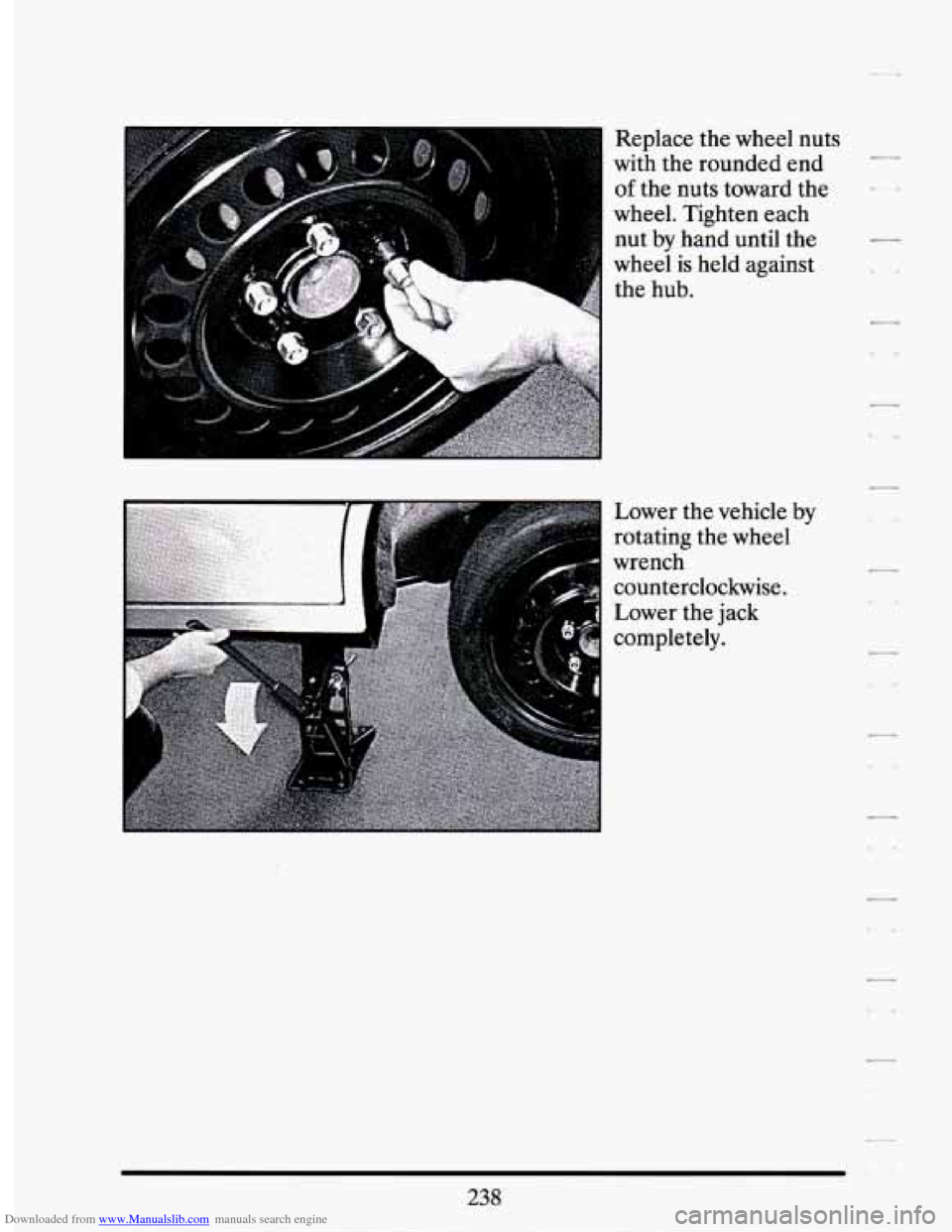
Downloaded from www.Manualslib.com manuals search engine Replace the wheel nuts
with the rounded end
of the nuts toward the
wheel. Tighten each
nut
by hand until the
wheel is held against the hub.
Lower the vehicle
by
rotating the wheel
wrench
counterclockwise.
238
Page 252 of 399
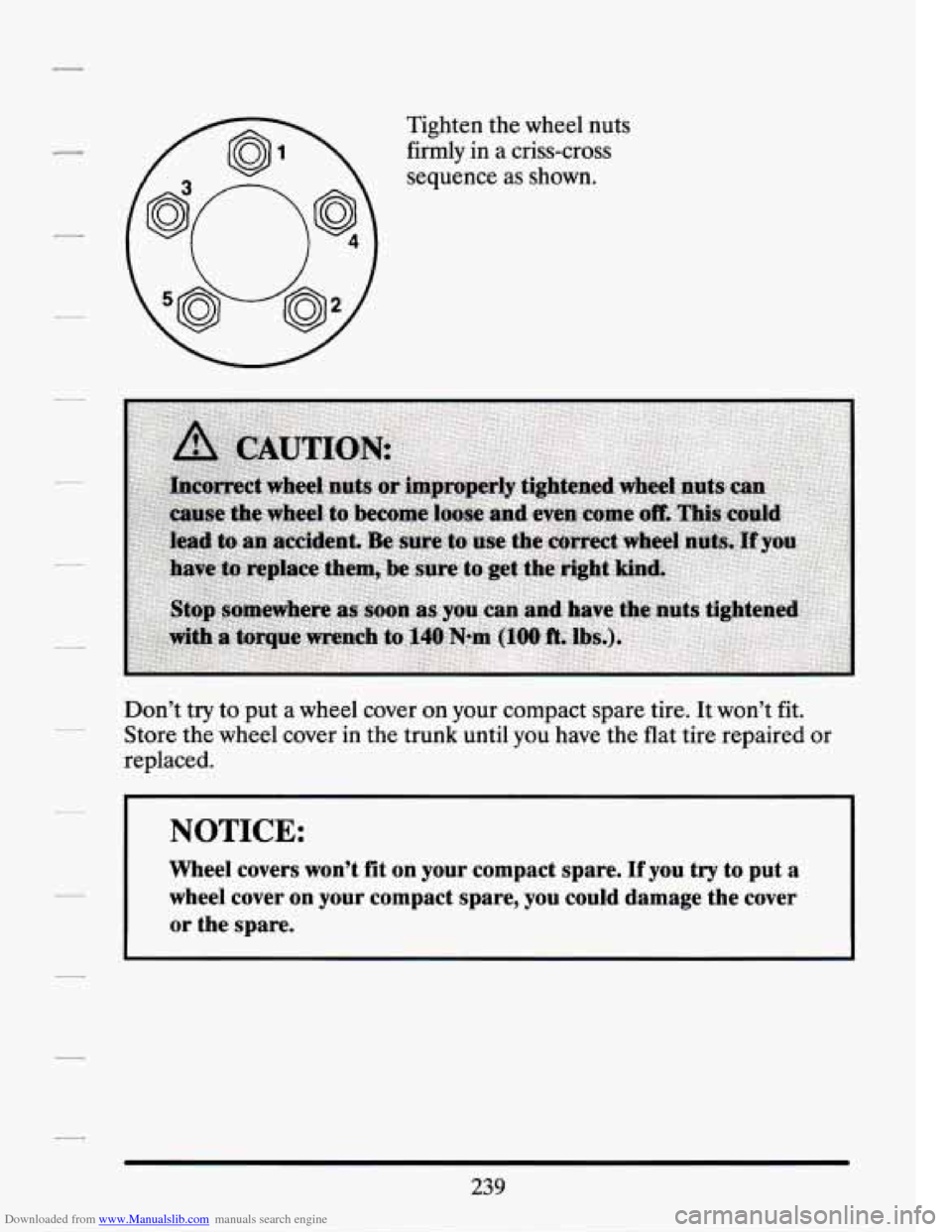
Downloaded from www.Manualslib.com manuals search engine Tighten the wheel nuts
firmly in a criss-cross
sequence
as shown.
Don’t try to put
a wheel cover on your compact spare tire. It won’t fit.
Store the wheel cover in the trunk until you have the flat tire repaired or
replaced. __
NOTICE:
Wheel covers won’t fit on your compact spare. If you try to put a
wheel cover
on your compact spare, you could damage the cover
or the spare.
239
Page 253 of 399
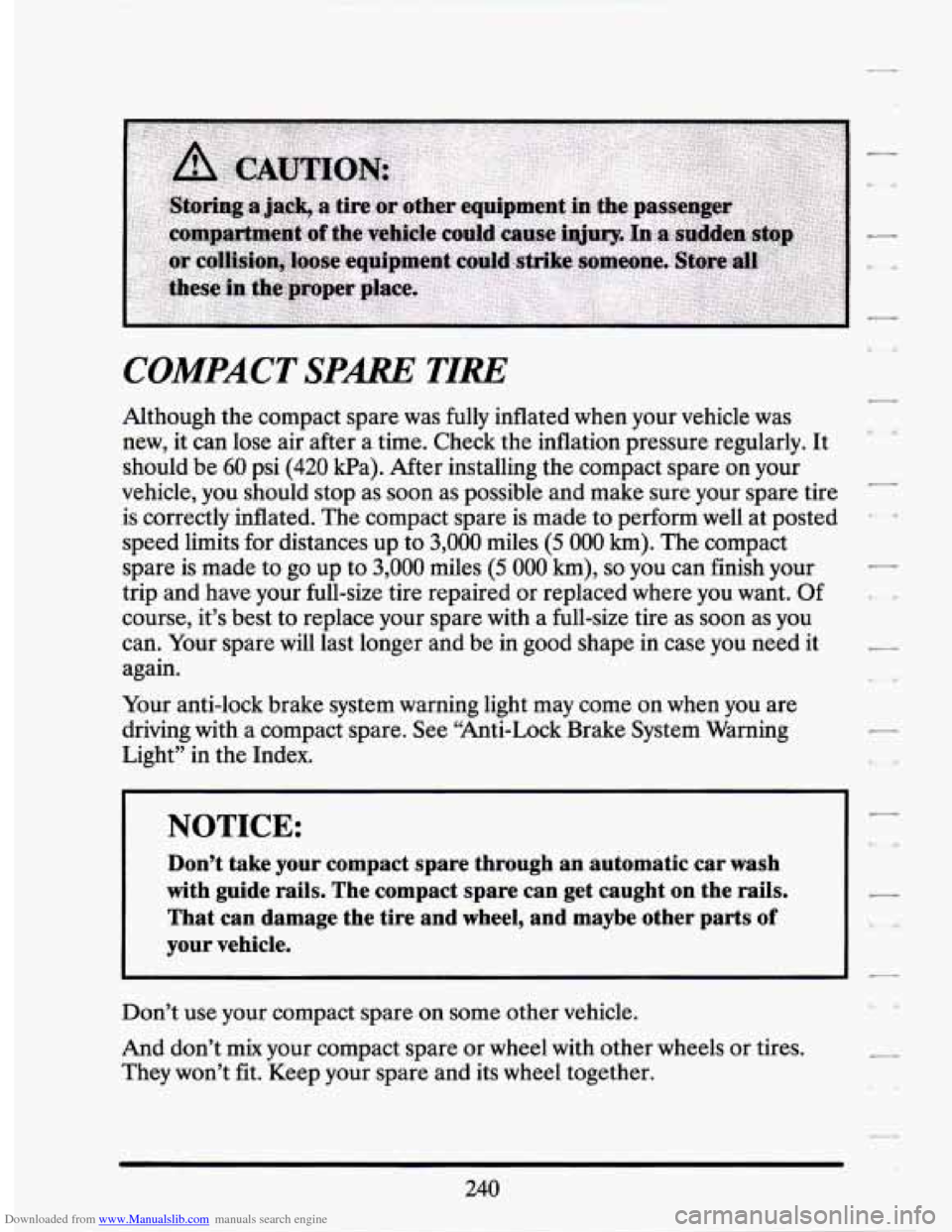
Downloaded from www.Manualslib.com manuals search engine COMPACT SPARE TIRE
Although the compact spare was fully inflated when your vehicle was
new, it can lose air after a time. Check the inflation pressure regularly. It
should be
60 psi (420 Wa). After installing the compact spare on your
vehicle, you should stop as soon as possible and make sure your spare tire
is correctly inflated. The compact spare is made to perform well at posted
speed limits for distances up to
3,000 miles (5 000 km). The compact
spare is made to go up to
3,000 miles (5 000 km), so you can finish your
trip and have your full-size tire repaired or replaced where you want. Of
course, it’s best to replace your spare with a full-size tire as soon as you
can. Your spare will last longer and be
in good shape in case you need it
again.
Your anti-lock brake system warning light may come on when you are
driving with a compact spare. See “Anti-Lock Brake System Warning
Light”
in the Index.
NOTICE:
Don’t take your compact spare through an automatic car wash \
with guide rails. The compact spare can get caught on the rails.
That can damage the tire and wheel, and maybe other parts
of
your vehicle.
Don’t use your compact spare on some other vehicle.
And don’t
mix your compact spare or wheel with other wheels or tires.
They won’t fit. Keep your spare and its wheel together.
7
240
Page 254 of 399

Downloaded from www.Manualslib.com manuals search engine NOTICE:
Tire chains won’t fit your compact spare. Using them will
damage your vehicle and destroy the chains too. Don’t use t\
ire
chains
on your compact spare.
SPARE TIRE
IF YOU’RE STUCK: INSAND, MUD,
ICE OR SNOW
What you don’t want to do when your vehicle is stuck is to spin your
wheels. The method known as “rocking” can help you get out when
you’re stuck, but you must use caution.
241
Page 255 of 399
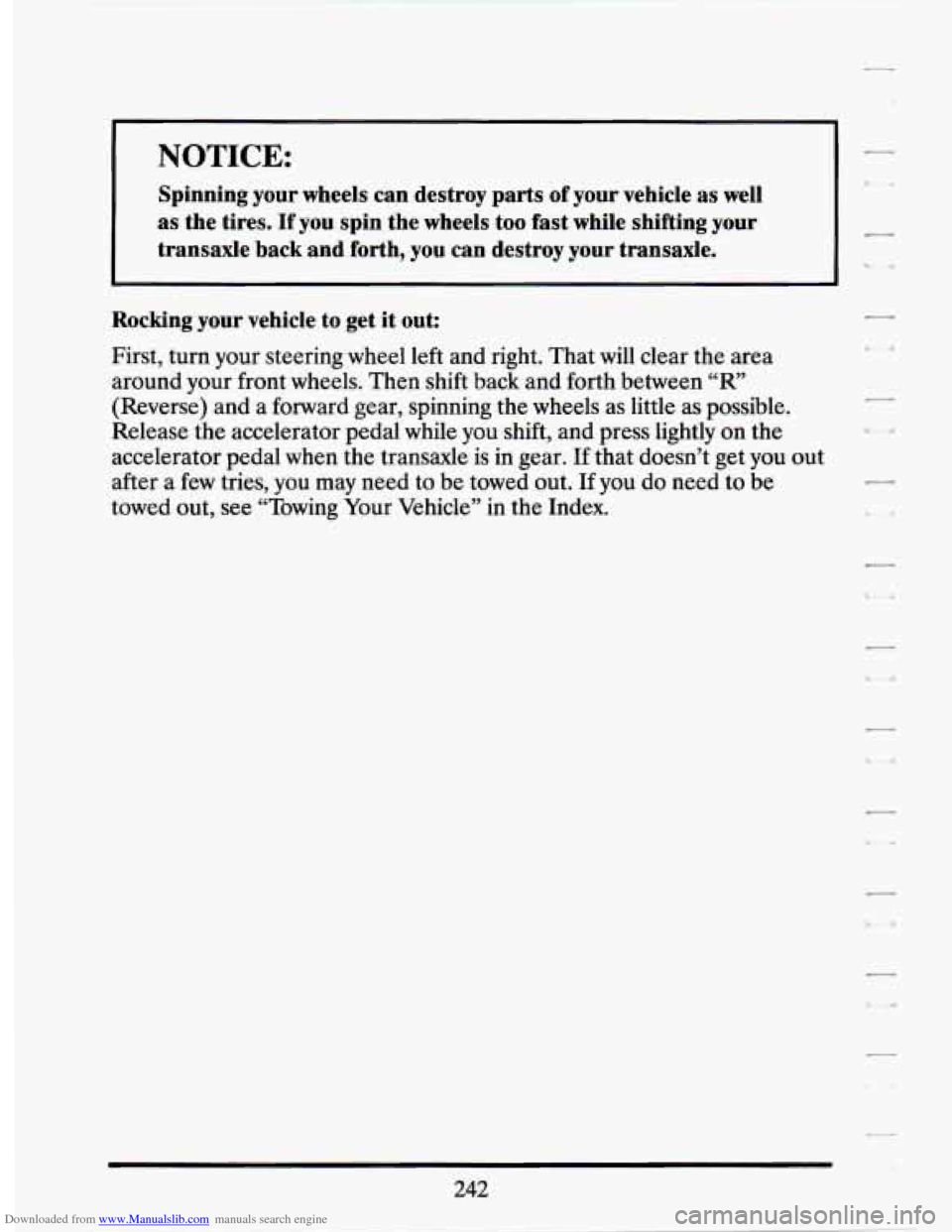
Downloaded from www.Manualslib.com manuals search engine NOTICE:
Spinning your wheels can destroy parts of your vehicle as well
as the tires. If you spin the wheels too fast while shifting you\
r
transaxle back and forth, you can destroy your transaxle.
Rocking your vehicle to get it out:
First, turn your steering wheel left and right. That will clear the area
around your front wheels. Then shift back and forth between
“R”
(Reverse) and a forward gear, spinning the wheels as little as possible.
Release the accelerator pedal while
you shift, and press lightly on the
accelerator pedal when the transaxle is in gear. If that doesn’t get you
out
after a few tries, you may need to be towed out. If you do need to be
towed out, see “Towing Your Vehicle” in the Index.
242
Page 256 of 399
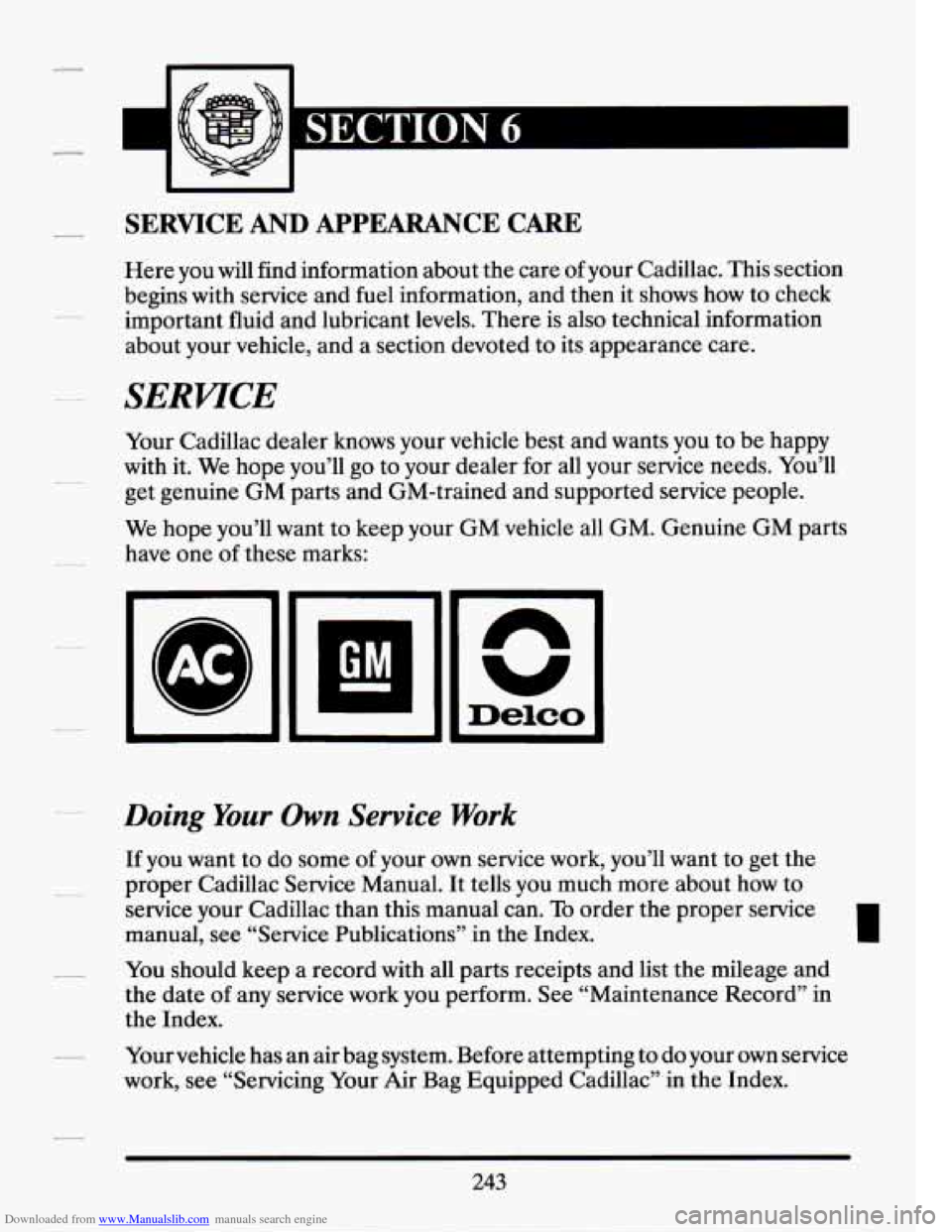
Downloaded from www.Manualslib.com manuals search engine SERVICE AND APPEARANCE CARE
Here you will find information about the care of your Cadillac. This section
begins with service and fuel information, and then
it shows how to check
important fluid and lubricant levels. There is also technical information
about your vehicle, and a section devoted to its appearance care.
SERWCE
Your Cadillac dealer knows your vehicle best and wants you to be happy
with it. We hope you’ll go to your dealer for all your service needs. You’ll
get genuine GM parts and GM-trained and supported service people.
We hope you’ll want to keep your GM vehicle all GM. Genuine GM parts
have one of these marks:
n
Delco
Doing Your Own Service Work
If you want to do some of your own service work, you’ll want to get the
proper Cadillac Service Manual. It tells
you much more about how to
service your Cadillac than this manual can.
To order the proper service
manual, see “Service Publications” in the Index.
I
You should keep a record with all parts receipts and list the mileage and
the date of any service work you perform. See “Maintenance Record” in
the Index.
Your vehicle has an air bag system. Before attempting to do your own service
work,
see “Servicing Your Air Bag Equipped Cadillac” in the Index.
243
Page 257 of 399
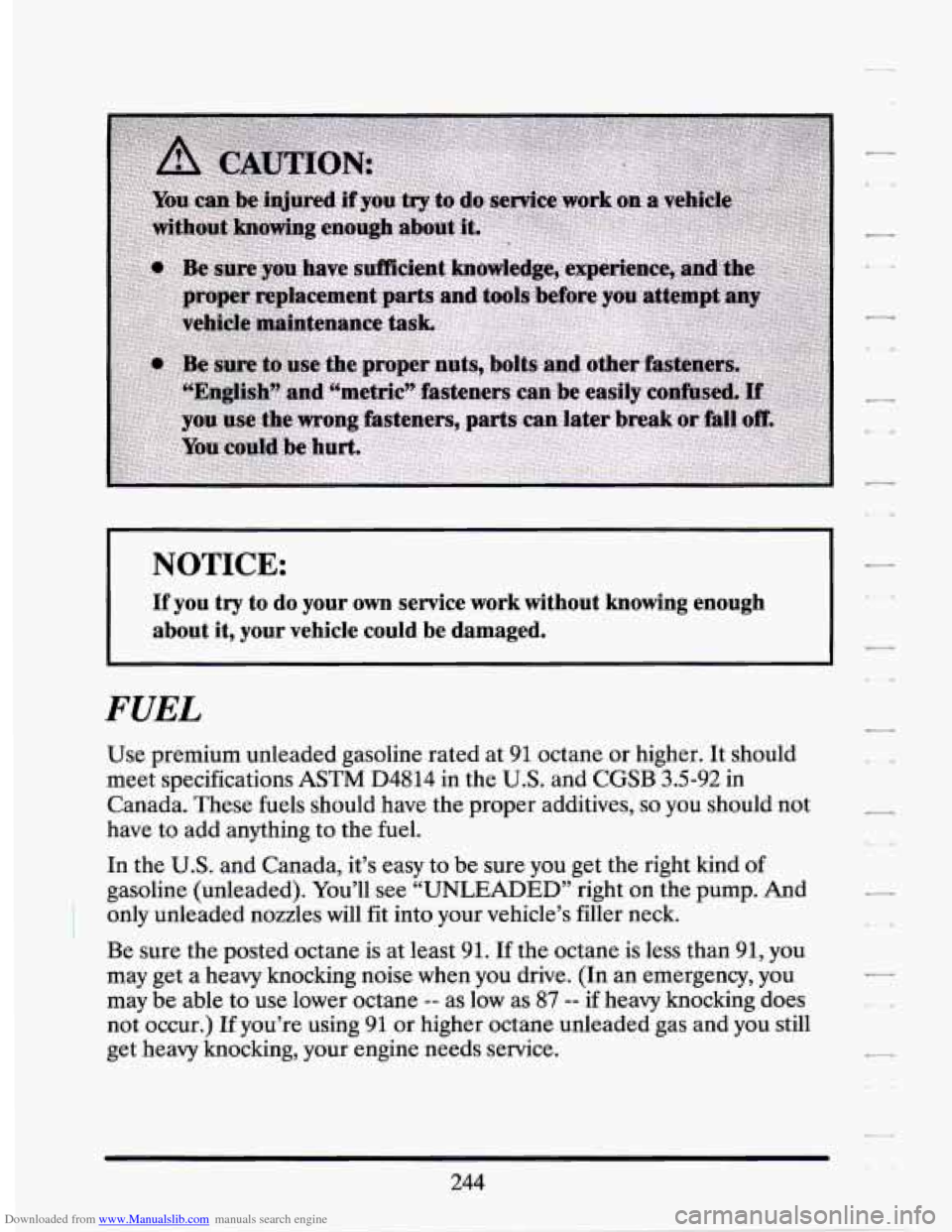
Downloaded from www.Manualslib.com manuals search engine NOTICE:
If you try to do your own service work without knowing enough
about it, your vehicle could be damaged.
FUEL
Use premium unleaded gasoline rated at 91 octane or higher. It should
meet specifications ASTM D4814
in the U.S. and CGSB 3.5-92 in
Canada. These fuels should have the proper additives,
so you should not
have to add anything to the fuel.
In the U.S. and Canada, it’s easy to be sure you get
the right kind of
gasoline (unleaded). You’ll see “UNLEADED” right on the pump. And
only unleaded nozzles will fit into your vehicle’s filler neck.
Be sure the posted octane is at least 91. If the octane is less than 91, you
may get a heavy knocking noise when you drive. (In an emergency, you
may be able to use lower octane
-- as low as 87 -- if heavy knocking does
not occur.)
If you’re using 91 or higher octane unleaded gas and you still
get heavy knocking, your engine needs service.
7
244
Page 258 of 399
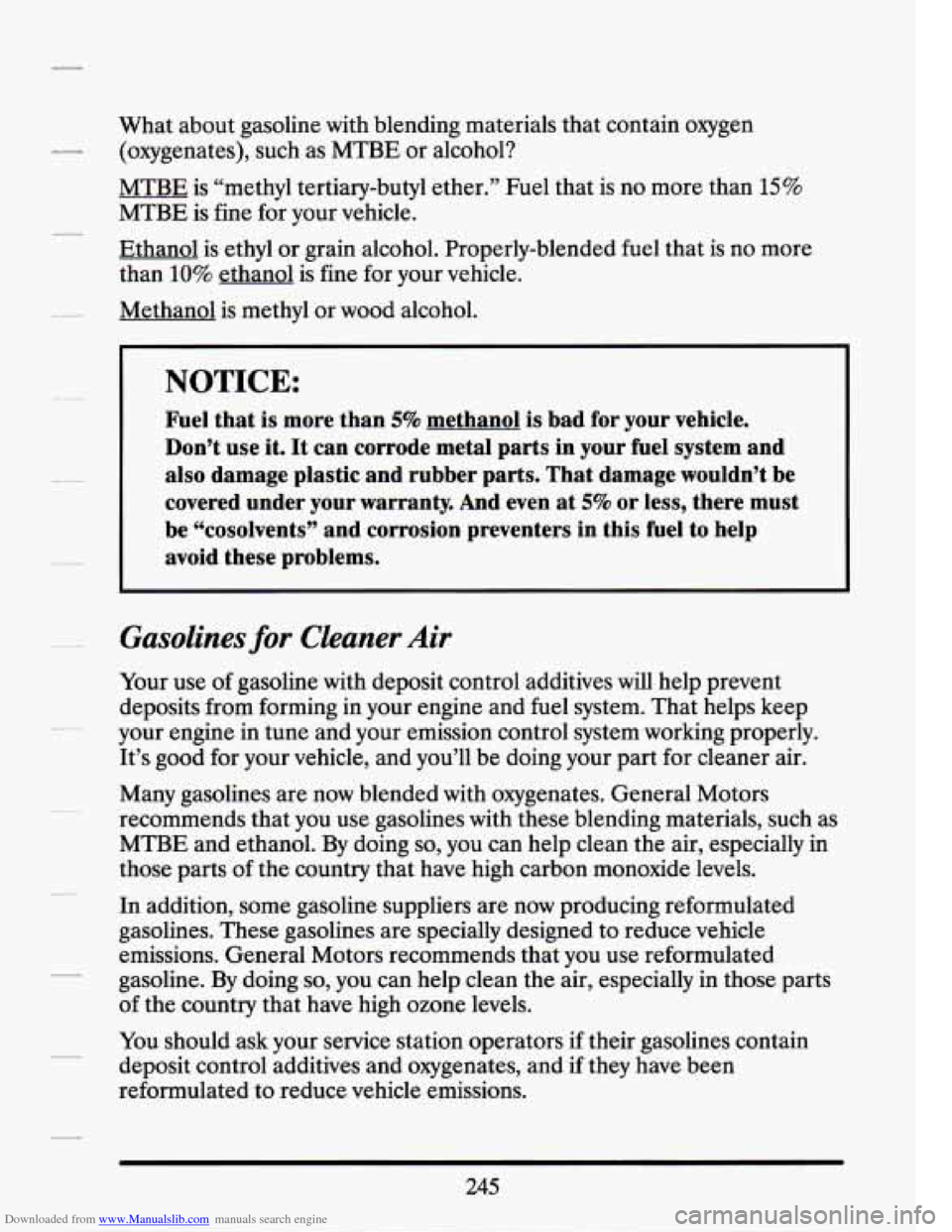
Downloaded from www.Manualslib.com manuals search engine What about gasoline with blending materials that contain oxygen
(oxygenates), such as MTBE or alcohol?
MTBE is “methyl tertiary-butyl ether.” Fuel that is
no more than 15%
MTBE is fine for your vehicle.
Ethanol is ethyl or grain alcohol. Properly-blended fuel that is no more
than
10% ethanol is fine for your vehicle.
Methanol is methyl or wood alcohol.
NOTICE:
Fuel that is more than 5% methanol is bad for your vehicle.
Don’t use it. It can corrode metal parts in your fuel system and
also damage plastic and rubber parts. That damage wouldn’t be
covered under your warranty. And even at
5% or less, there must
be “cosolvents” and corrosion preventers in this fuel to help\
avoid these problems.
Gusolines for Cleaner Air
Your use of gasoline with deposit control additives will help prevent
deposits from forming in your engine and fuel system. That helps keep
your engine in tune and your emission control system working properly.
It’s good for your vehicle, and you’ll be doing your part for cleaner air.
Many gasolines are now blended with oxygenates. General Motors
recommends that you use gasolines with these blending materials, such as
MTBE and ethanol. By doing
so, you can help clean the air, especially in
those parts of the country that have high carbon monoxide levels.
In addition, some gasoline suppliers are now producing reformulated
gasolines. These gasolines are specially designed
to reduce vehicle
emissions. General Motors recommends that you use reformulated
gasoline. By doing
so, you can help clean the air, especially in those parts
of the country that have high ozone levels.
You should ask your service station operators if their gasolines contain
deposit control additives and oxygenates, and
if they have been
reformulated to reduce vehicle emissions.
245
Page 259 of 399
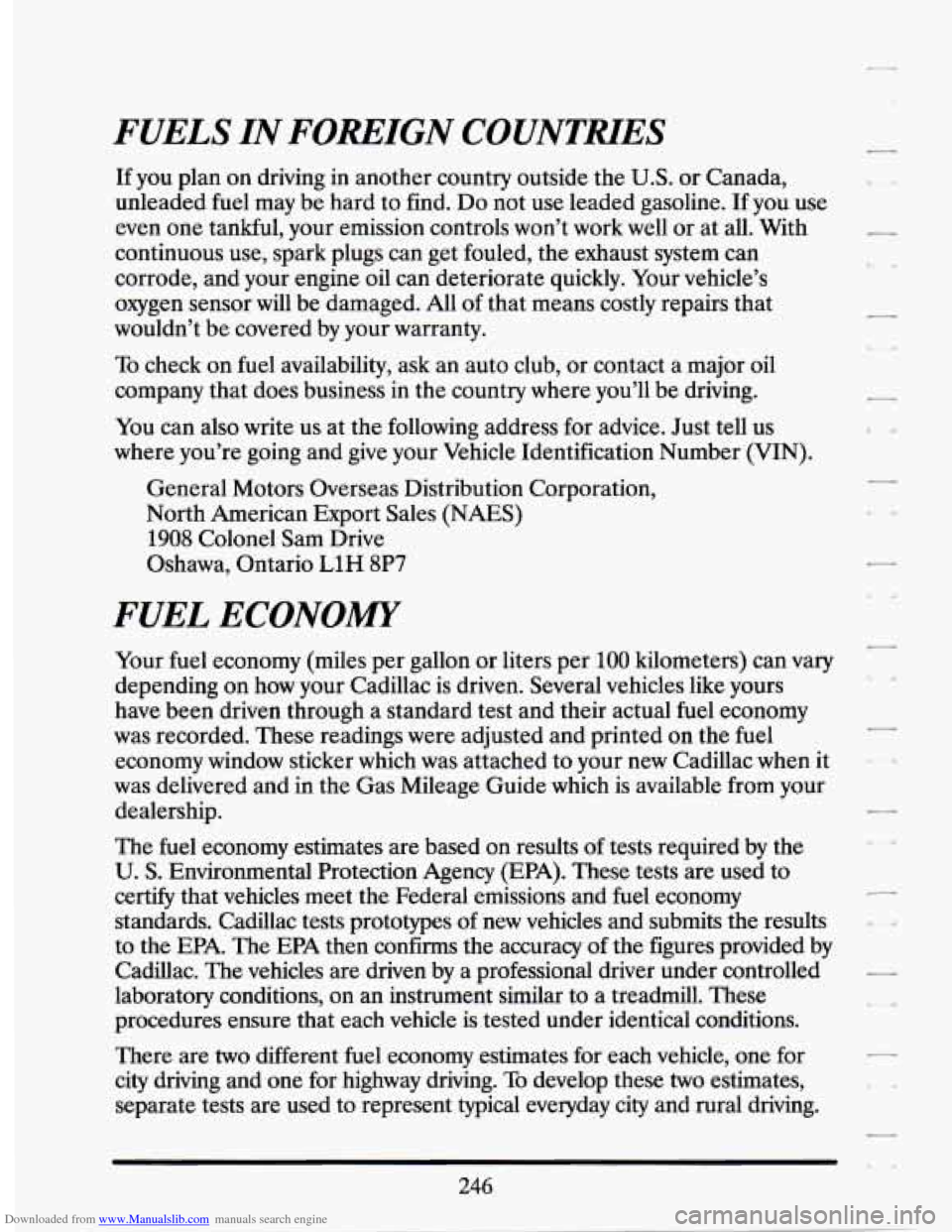
Downloaded from www.Manualslib.com manuals search engine FUELS IN FOREIGN COUNTHES
If you plan on driving in another country outside the U.S. or Canada,
unleaded fuel may be hard to find. Do not use leaded gasoline. If you use
even one tankful, your emission controls won’t work well or at all. With
continuous use, spark plugs can get fouled, the exhaust system can
corrode, and your engine oil can deteriorate quickly. Your vehicle’s
oxygen sensor will be damaged. All of that means costly repairs that
wouldn’t be covered by your warranty.
To check on fuel availability, ask an auto club, or contact a major oil
company that does business in the country where you’ll be driving.
You can also write us at the following address for advice. Just tell us
where you’re going and give your Vehicle Identification Number (VIN).
General Motors Overseas Distribution Corporation,
North American Export Sales (NAES)
1908 Colonel Sam Drive
Oshawa, Ontario
L1H 8P7
FUEL ECOlVOhfY
Your fuel economy (miles per gallon or liters per 100 kilometers) can vary
depending on how your Cadillac is driven. Several vehicles like yours
have been driven through a standard test and their actual fuel economy
was recorded. These readings were adjusted and printed on the fuel
economy window sticker which was attached to your
new Cadillac when it
was delivered and in the Gas Mileage Guide which is available from your
dealership.
c
The fuel economy estimates are based on results of tests required by the
U. S. Environmental Protection Agency (EPA). These tests are used to
certify that vehicles meet the Federal emissions and fuel economy
standards. Cadillac tests prototypes of new vehicles and submits the results
to the EPA. The EPA then confirms the accuracy
of the figures provided by
Cadillac. The vehicles are driven by a professional driver under controlled
-
laboratory conditions, on an instrument similar to a treadmill. These
procedures ensure that each vehicle is tested under identical conditions.
There are
two different fuel economy estimates for each vehicle, one for
city driving and one for highway driving.
To develop these two estimates,
separate tests are used to represent typical everyday city and rural driving.
LI
.
246
Page 260 of 399
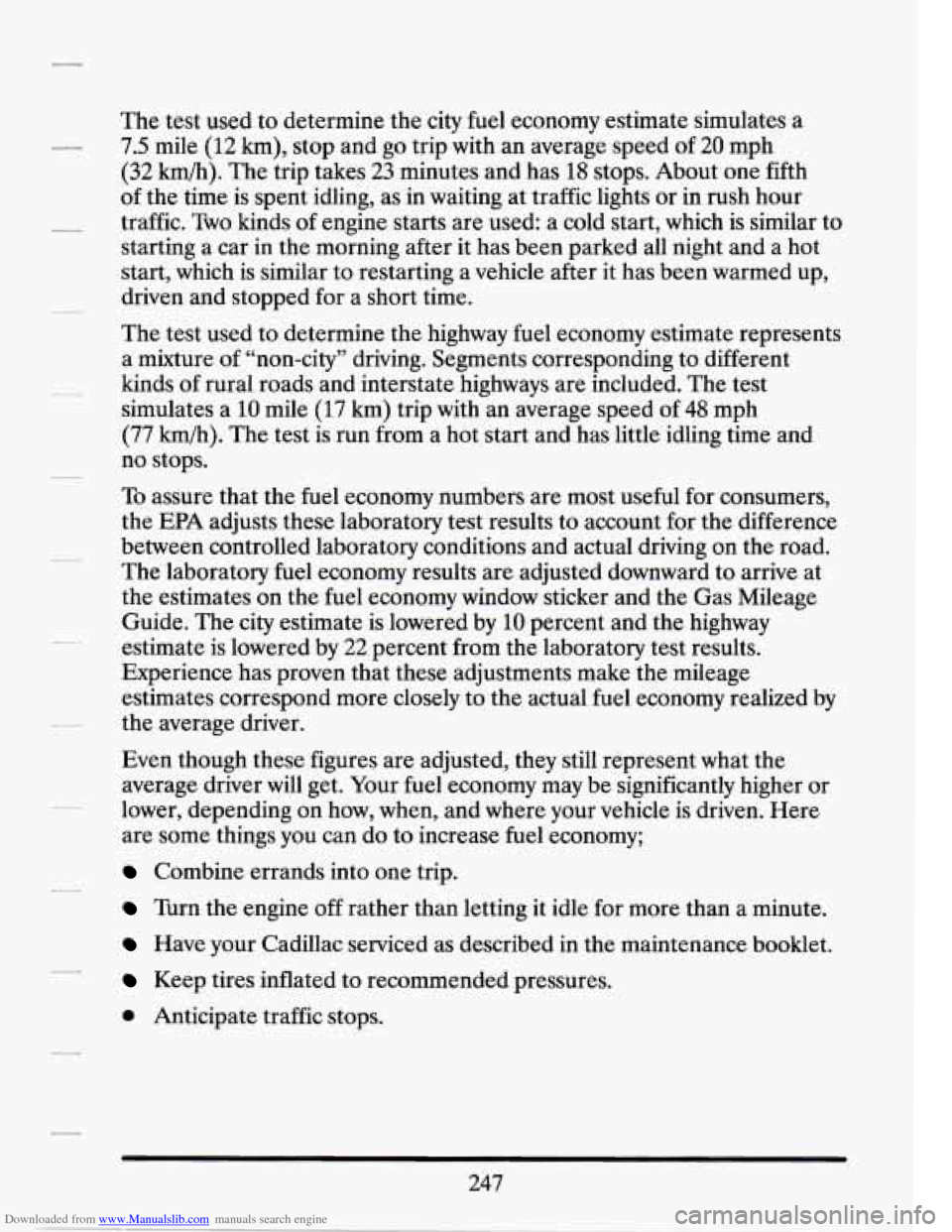
Downloaded from www.Manualslib.com manuals search engine -
The test used to determine me city fuel economy estimate simulates a
7.5 mile
(12 km), stop and go trip with an average speed of 20 mph
(32 km/h). The trip takes 23 minutes and has 18 stops. About one fifth
of the time is spent idling, as in waiting at traffic lights or in rush hour
traffic. Two kinds
of engine starts are used: a cold start, which is similar to
starting a car in the morning after it has been parked all night and a hot
start, which is similar to restarting
a vehicle after it has been warmed up,
driven and stopped for a short time.
The test used to determine the highway fuel economy estimate represents
a mixture
of “non-city” driving. Segments corresponding to different
kinds of rural roads and interstate highways are included. The test
simulates a
10 mile (17 km) trip with an average speed of 48 mph
(77
km/h). The test is run from a hot start and has little idling time and
no stops.
To assure that the fuel economy numbers are most useful for consumers,
the EPA adjusts these laboratory test results to account for the difference
between controlled laboratory conditions and actual driving on the road.
The laboratory fuel economy results are adjusted downward to arrive at
the estimates on the fuel economy window sticker and the Gas Mileage
Guide. The
city estimate is lowered by 10 percent and the highway
estimate is lowered by
22 percent from the laboratory test results.
Experience has proven that these adjustments make the mileage
estimates correspond more closely to the actual fuel economy realized by
the average driver.
Even though these figures are adjusted, they still represent what the
average driver will get. Your fuel economy may be significantly higher or
lower, depending on how, when, and where your vehicle is driven. Here
are some things you can do to increase fuel economy;
Combine errands into one trip.
Turn the engine off rather than letting it idle for more than a minute.
Have your Cadillac serviced as described in the maintenance booklet.
Keep tires inflated to recommended pressures.
0 Anticipate traffic stops.
247